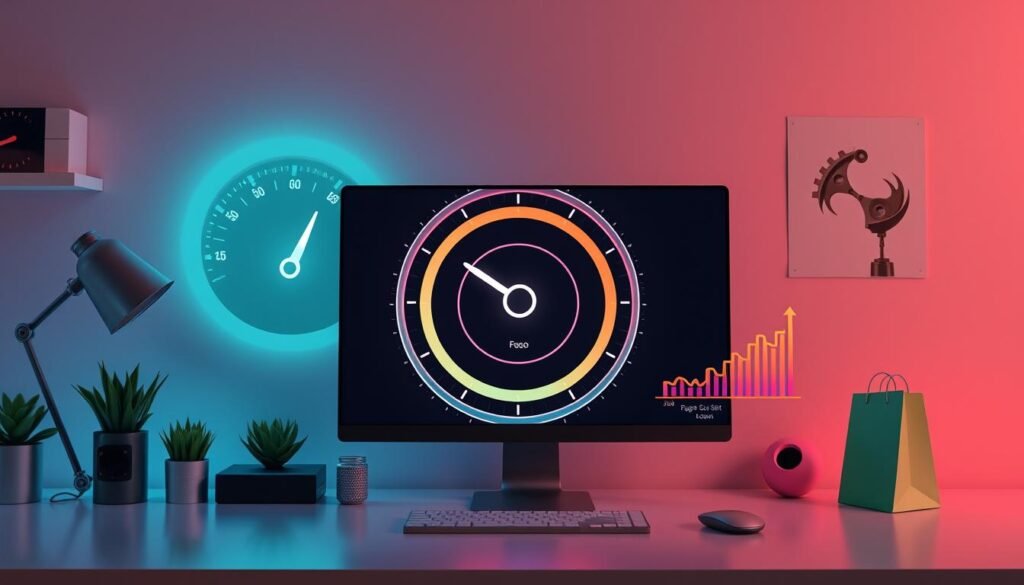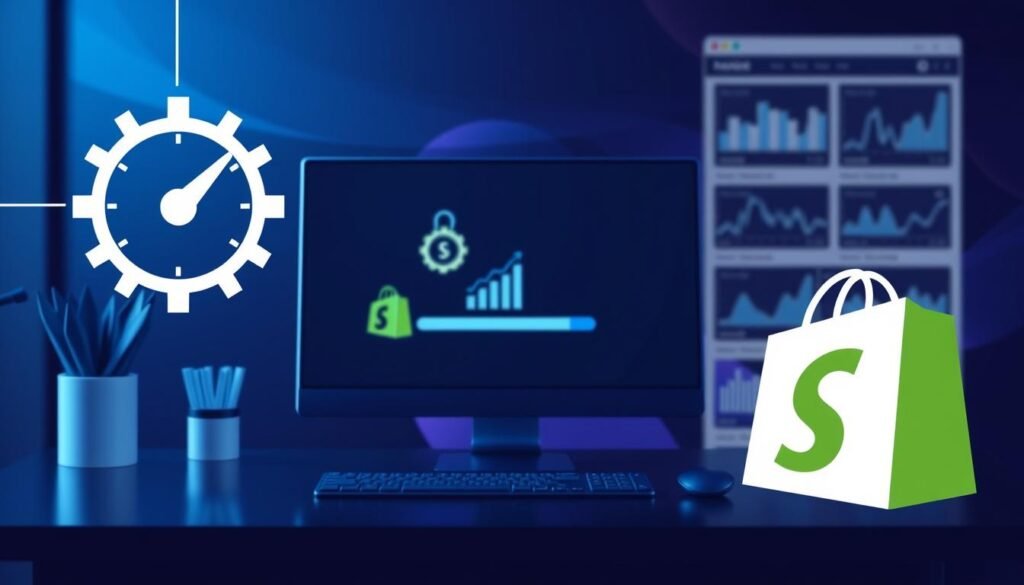Did you know a one-second speed boost can add $8,000 to your revenue? This shows why fast website loading is so important. If you want to make your Shopify store faster, you’re in the right spot. A quick website not only makes users happy but also helps with search rankings.
Speed is key in today’s fast-paced online world. Choosing the right Shopify theme, like Dawn, and optimizing images are key. Big images and third-party scripts can slow you down. It’s time to explore how to make your Shopify store faster.
Key Takeaways
- Understanding that a one-second increase in page speed can significantly raise revenue is key.
- Choosing a fast Shopify theme is essential for good site performance.
- Smaller images and lazy loading are important for faster page loading.
- Streamlining third-party scripts and apps is vital to avoid slowdowns.
- Improving site speed benefits user experience and search rankings.
- Regularly check your store’s features and assets to keep it fast.
- Using Shopify’s CDN and managing apps can improve your shopping experience.
Understanding the Impact of Speed on Your Shopify Store
As an online merchant, knowing how to make your Shopify site faster is key. It’s not just about a better user experience. It’s also about boosting your store’s success. Fast sites keep customers coming back and increase your earnings.
Let’s explore how speed affects your Shopify store. We’ll look at the data and share tips to help you.
The Direct Correlation Between Page Speed and Conversions
Studies show that 70% of consumers look at website speed when shopping online. A small improvement in page load time can increase conversions a lot. For example, a one-second delay can cost a store making $60 per order about $9,000 a day.
Why Performance is a Ranking Factor in Google’s Algorithm
Google wants eCommerce sites to load in two seconds. This makes site speed a key SEO factor. With Google’s big share of the search market, making your Shopify site fast is a must.
Faster sites rank better, thanks to Google’s updates in May 2021. This change made site speed even more important for SEO.
Improving Site Speed Across Digital Marketing Initiatives
Boosting your Shopify store’s speed helps more than just SEO. It also improves your digital marketing efforts. Faster sites lead to better results in paid ads and social media.
For instance, a one-second speed boost can raise mobile conversion rates by up to 27%. This is important because 70% of shoppers buy on mobile.
Shopify is known for its fast performance. Stores on Shopify load 1.8 times faster than others. With great performance and features like intelligent lazy loading, Shopify owners have a strong base to grow from.
| Factor | Impact on Speed | Resulting Benefit |
|---|---|---|
| Page Speed Improvement | Half-second increase | Higher conversion rates |
| Google’s Speed Recommendation | 2 seconds for eCommerce | Improved SEO Rankings |
| Shopify’s Performance | 1.8x faster than competitors | Enhanced user experience and uptime |
| Mobile Conversions | Improvement by up to 27% | Increased mobile sales |
How to Increase Shopify Page Speed
To speed up your Shopify store, start with a detailed plan. Focus on several technical areas. This will make your site faster, leading to happier customers and more sales. Here’s how to get started:
Selecting a Speed-Optimized Shopify Theme
Picking the right theme is key to fast performance. Themes like ‘Create’ or ‘Light Themes’ are made for speed. They cut out extra stuff that slows you down. Choose themes that are fast and well-supported.
Optimizing Images to Reduce File Size
Images are a big part of your site. They should be small to load quickly. Use JPEGs for photos and PNGs for logos. Keep images under 4472 x 4472 pixels and 20 MB for the best speed.
Using Lazy Loading to Prioritize Above-the-Fold Content
Lazy loading is great for sites with lots of images. It loads only what you see first, making pages faster. As you scroll, more content loads smoothly. This saves bandwidth and makes your site faster.
Making checkout faster is also important. It keeps customers happy and reduces cart drops. By improving your site’s speed, you’ll keep and attract more customers.
| Optimization Technique | Benefits |
|---|---|
| Selecting a Speed-Optimized Theme | Improves overall load time, reduces need for additional speed enhancements. |
| Optimizing Image File Sizes | Decreases page load times, enhances SEO, improves user experience. |
| Implementing Lazy Loading | Initial page loads faster, reduces resource load on server, improves time to interactive. |

Debloating Your Shopify Store for Better Performance
To make your Shopify store faster, debloating is key. It reduces unnecessary bulk, making your site run smoother. Here’s how to debloat your store:
Optimize Your Image Files: Big images slow down your site. Compressing them and using formats like WebP can make them smaller without losing quality.
Streamline Your Apps and Themes: Too many apps or custom features slow your site. Only keep what’s necessary. Choose simple, fast themes to speed up your site.
- Don’t overload with too many heavy elements like GIFs.
- Use less third-party JavaScript to speed up loading.
Use speed tools to check how each change helps your site. This ensures your site gets faster.

| Product Type | Description | Impact on Load Time |
|---|---|---|
| Enhanced Shopify Themes | Simplified, with focus on speed optimization | Reduces load time significantly |
| Optimized Images | Compressed and in modern formats like WebP | Decreases page weight, enhances speed |
| Minimized App Usage | Only essential apps retained | Lowers number of requests, improves performance |
Keep an eye on your site’s speed after debloating. Google PageSpeed Insights can help see how well you’ve done and what else to work on.
Making your Shopify store faster helps your customers and your SEO. It makes your site rank higher and attract more visitors. With these changes, you’ll offer a better shopping experience.
Critical Techniques for Shopify Speed Optimization
To make your Shopify pages faster, it’s key to use smart speed optimization tips. These tips improve user experience and help with SEO. Speed matters a lot, as a small improvement can boost conversions. But, a delay can cost a lot of money.
Implementing Browser Caching and Utilizing CDNs Effectively
Browser caching and CDNs are great for quick load times. Browser caching saves webpage files on your computer, making future visits faster. Shopify works with Fastly, a CDN, to make content load quicker, no matter where you are.
CDNs can save up to 60% of bandwidth. This makes them a powerful tool for better site performance.
Minimizing Third-Party Scripts and Shopify Apps
Shopify apps are useful, but they can slow down your site. It’s smart to keep only the apps you really need. Removing unused apps and scripts helps your site run smoothly.
By cutting down on scripts, your Shopify store can load faster. This keeps your site efficient and fast.
Enhancing Speed Through Advanced Shopify Features
Using advanced Shopify features like AMP for mobile content and Image Manager for image compression can make a big difference. Shopify also updates its infrastructure regularly, improving site speed by 35% in a year.
These tools help you stay ahead in the fast e-commerce world. They also help with the growing mobile traffic, expected to hit $3.56 trillion this year.
Make sure your Shopify theme is also optimized for speed. Regular updates prevent slowdowns. Taking care of these details makes your site fast, efficient, and more likely to keep and convert visitors.
Conclusion
This article has given you a detailed guide on how to boost Shopify page speed. It shared essential tips for optimizing your store’s speed. With 53% of shoppers expecting pages to load in under three seconds, fast loading is critical.
We talked about starting with a lean Shopify theme and compressing images to fit your store’s layout. Lazy loading also plays a big role in reducing initial load times. This makes shopping better for 33% of Americans who buy online on Shopify.
Unnecessary code from uninstalled apps and too many active apps slow down your store. It’s important to manage and minimize third-party scripts. Improving page speed by one second can increase conversions and customer satisfaction.
Site speed is also a key factor for Google rankings. This means optimizing your site can improve both user experience and SEO. For example, a Shopify site’s score jumped from 66 to 76 on mobile and 88 on desktop after optimization.
As competition grows and shoppers get impatient, speeding up your Shopify store is essential. We covered using the right image formats, lazy loading, and limiting third-party JavaScript. Regularly updating these strategies and following Shopify’s recommendations will help your store succeed.

